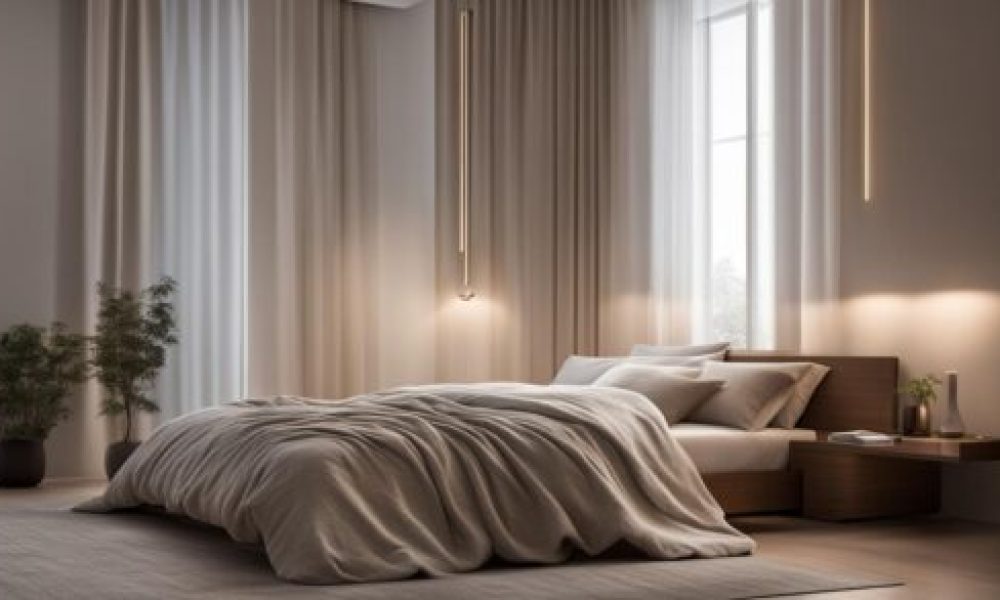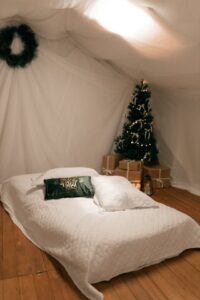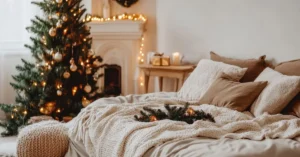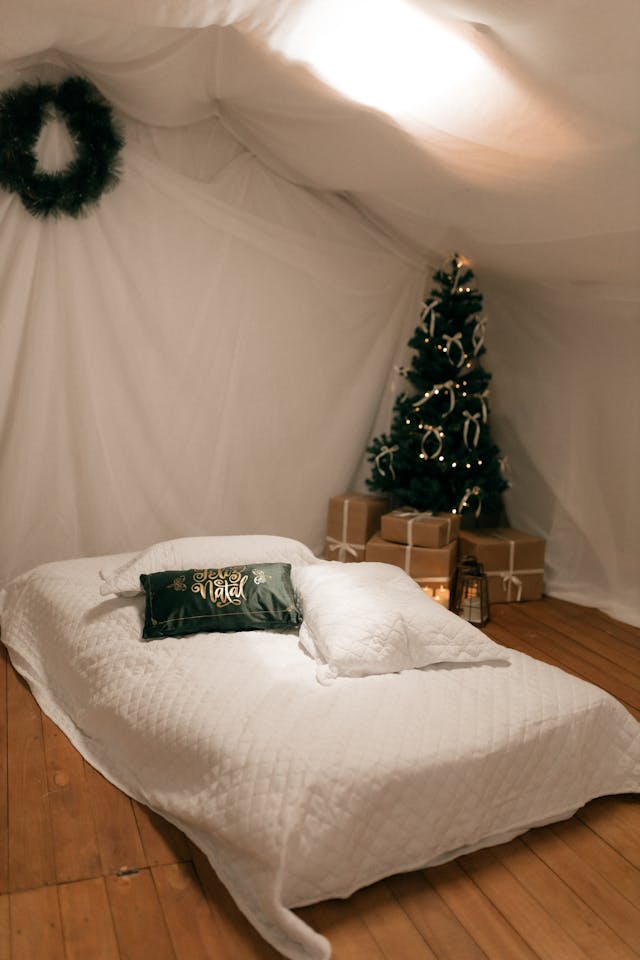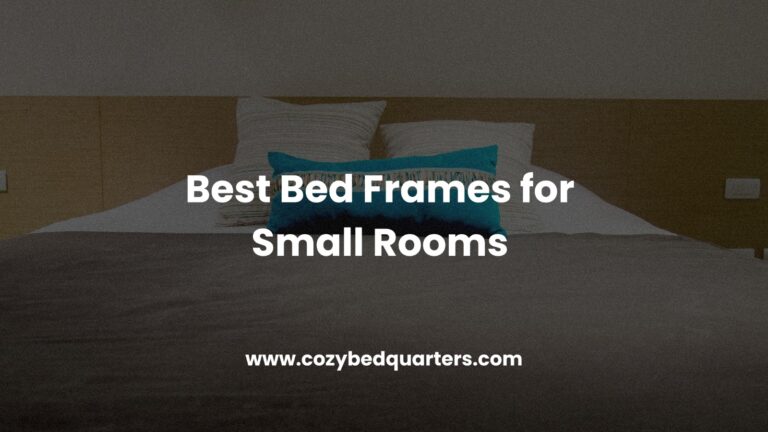Sleep Environment: Create a Quieter Space with Noise Reduction Tips
Brightened Intro
A calmer sleep environment starts with three levers: keep your room cool (about 60–67°F / 15.6–19.4°C), block or mask noise, and remove stray light. Layer in supportive bedding, decluttered surfaces, restful colors, and gentle background sound to fall asleep faster and stay asleep longer.
Key Takeaways
- Creating a quiet sleep environment can greatly enhance your sleep quality.
- Optimize your bedroom temperature to around 65°F (18.3°C) for optimal sleep.
- Reduce noise disturbances with noise-blocking curtains, fans, or white noise machines.
- Keep the room dark with room-darkening drapes or blinds and screen discipline.
- Invest in a supportive mattress and breathable bedding to improve comfort and back support.
Temperature and Sleep Quality
Short answer: Most people sleep best in a cool room—aim near 65°F (18.3°C), adjusting within 60–71.6°F (15.6–22.0°C) to your comfort.
The temperature of your bedroom plays a crucial role in sleep quality. A comfortably cool space helps lower core body temperature and promotes sleepiness.
To fine‑tune comfort, adjust your bedding layers:
- Use breathable materials: Cotton or bamboo sheets and pajamas improve air circulation.
- Layer your bedding: Add or remove light blankets to dial in warmth quickly.
- Try cooling tech: Consider a cooling mattress or topper if you sleep hot.
Table: Summary of Bedroom Temperature Recommendations
| Bedroom Temperature (Fahrenheit) | Bedroom Temperature (Celsius) | Recommended Sleep Quality |
|---|---|---|
| 60–64 | 15.6–17.8 | Excellent |
| 65 | 18.3 | Optimal |
| 66–69 | 18.9–20.6 | Good |
| 70–71.6 | 21.1–22.0 | Fair |
Noise Reduction for Better Sleep
Short answer: Block outside sounds, quiet inside sources, and mask the rest with consistent white noise to protect deep sleep.
Excessive noise can fragment sleep and affect daytime energy. Combine physical barriers with sound masking for the calmest results.
External Noise Reduction
Do this first: Add mass at windows, close gaps, and use steady masking sound.
- Use noise‑blocking curtains or blinds to soften traffic and street sounds.
- Run a white noise machine or fan to mask irregular noises.
- Keep windows closed during high‑noise periods.
Internal Noise Reduction
Quick wins: Remove small noisemakers and seal rattly gaps.
- Remove or silence ticking clocks and loud chargers.
- Weather‑strip doors and windows to minimize leaks.
- Set household “quiet hours.”
Creating a Peaceful Sleep Atmosphere
Bigger picture: Pair noise reduction with a tidy, soothing space to deepen relaxation.
- Keep surfaces clear and the room organized to promote a sense of calm.
- Use soft, cool‑tone colors to nudge the room toward tranquility.
- Add gentle nature sounds or low‑tempo music to ease pre‑sleep tension.
| Noise Reduction Strategies | Effectiveness |
|---|---|
| Using noise-blocking curtains or blinds | High |
| Installing a white noise machine | High |
| Sealing doors and windows | Moderate |
| Removing electronic devices that emit noise | Moderate |
| Establishing quiet hours | Moderate |
| Noise Reduction Strategies | Effectiveness |
|---|---|
| Using noise-blocking curtains or blinds | High |
| Installing a white noise machine | High |
| Sealing doors and windows | Moderate |
| Removing electronic devices that emit noise | Moderate |
| Establishing quiet hours | Moderate |

Creating a Dark Sleep Environment
Short answer: Block outdoor light, dim or hide screens, and keep clocks dark to support melatonin and deeper sleep.
Light exposure—especially blue light—can disrupt circadian rhythms. Use room‑darkening drapes or blinds to block streetlights and early sun. Store or power down bright devices at night.
“Sleeping in a dark environment can improve sleep quality and promote a more restorative sleep.” — Sleep Expert
Keep alarm clocks and phones face down or use blackout stickers. Even tiny LEDs can interrupt deep, restorative stages.
Benefits of a Dark Sleep Environment
- Promotes melatonin: Darkness signals “sleep time.”
- Reduces awakenings: Less light means fewer arousals.
- Aligns circadian rhythm: Reinforces night‑day timing.
- Encourages relaxation: Darkness naturally calms the mind.
| Light Exposure | Sleep Quality |
|---|---|
| High light exposure | Poor sleep quality |
| Low light exposure | Improved sleep quality |

Mattress and Bedding Selection for Optimal Comfort
Short answer: Choose a mattress that supports spinal alignment and breathable bedding that helps regulate temperature.
Your mattress and bedding shape your sleep comfort. Match firmness to your sleeping position and prefer breathable, moisture‑wicking fabrics.
Video overview: Choosing the right mattress (YouTube)
| Mattress Type | Pros | Cons |
|---|---|---|
| Memory Foam | Contours to your body, relieves pressure, minimizes motion transfer | May retain heat; possible initial off‑gassing |
| Innerspring | Bouncy feel, excellent airflow, durable | Less contouring; potential noise; lower motion isolation |
| Latex | Natural, hypoallergenic, conforming yet supportive, good airflow | Higher cost; heavier |
Pick pillows that match your sleep position (adjustable loft helps). For sheets, natural fibers like cotton and bamboo balance softness and breathability. Keep bedding clean per care labels to maintain a hygienic sleep environment.
Decluttering Your Sleep Space for Peace of Mind
Short answer: Clear visual noise to calm the mind—store work items elsewhere and keep surfaces simple.
A clutter‑free room reduces mental load and supports a smoother wind‑down. Remove non‑sleep items, avoid under‑bed storage if possible, and use closed storage to hide visual distractions.
Benefits of a Decluttered Sleep Space
- Reduced stress: Tidy rooms feel calmer.
- Improved focus: Fewer distractions help you drift off.
- Enhanced sleep quality: Less visual stimulation equals fewer awakenings.
- Momentum in the morning: An orderly start boosts productivity.
Choosing Relaxing Colors for Better Sleep
Short answer: Soft blues, greens, lavender, and gentle grays nudge the room toward calm.
Color influences mood. Blue can lower blood pressure and heart rate, green evokes natural tranquility, lavender can ease anxiety, and gray provides a quiet backdrop.
| Color | Effects on Sleep |
|---|---|
| Blue | Lowest blood pressure and heart rate; calming |
| Green | Evokes tranquility and relaxation |
| Lavender | May reduce anxiety and promote deep sleep |
| Gray | Creates a peaceful, neutral ambiance |
Incorporating Soothing Sounds for Peaceful Sleep
Short answer: Use steady background noise—white noise, fans, or nature sounds—to mask disruptions and maintain continuity of sleep.
White noise (or pink/brown noise) smooths out peaks from sporadic sounds. Nature tracks and gentle instrumentals can also set a relaxing tone. Experiment to find a soundscape that feels invisible yet comforting.
FAQ
- What is the best bedroom temperature for a sleep environment?
- Most sleepers do well around 65°F (18.3°C), with a workable range of 60–71.6°F (15.6–22.0°C). Start at 65°F and adjust by comfort.
- How can I quickly make my sleep environment quieter?
- Close windows, run a fan or white noise machine, and use heavy curtains. Silence small noisemakers and set household quiet hours.
- Do I need blackout curtains for a dark sleep environment?
- They help a lot—especially near streetlights or early sun. At minimum, use room‑darkening shades and cover bright LEDs and screens.
- What bedding is best if I sleep hot?
- Breathable sheets (cotton/bamboo) and a cooling topper or mattress with airflow. Avoid overly warm comforters and consider lighter layers.
- Which colors best support a calming bedroom?
- Soft blues, greens, lavender, and gentle grays tend to feel most restful and support a tranquil sleep environment.
Related Reading
- How to Choose the Right Pillow for Neck Support
- Best Thread Count for Cotton & Bamboo Sheets
- Blackout Curtains vs. Shades: What’s Better for Sleep?
- Cooling Mattress Toppers: A Buyer’s Guide
- White Noise vs. Brown Noise: Which Helps You Sleep?
Source Links
- https://www.sleepfoundation.org/bedroom-environment
- https://startsleeping.org/how-to-create-the-ideal-bedroom-for-better-sleep/
- https://www.sleepfoundation.org/noise-and-sleep

